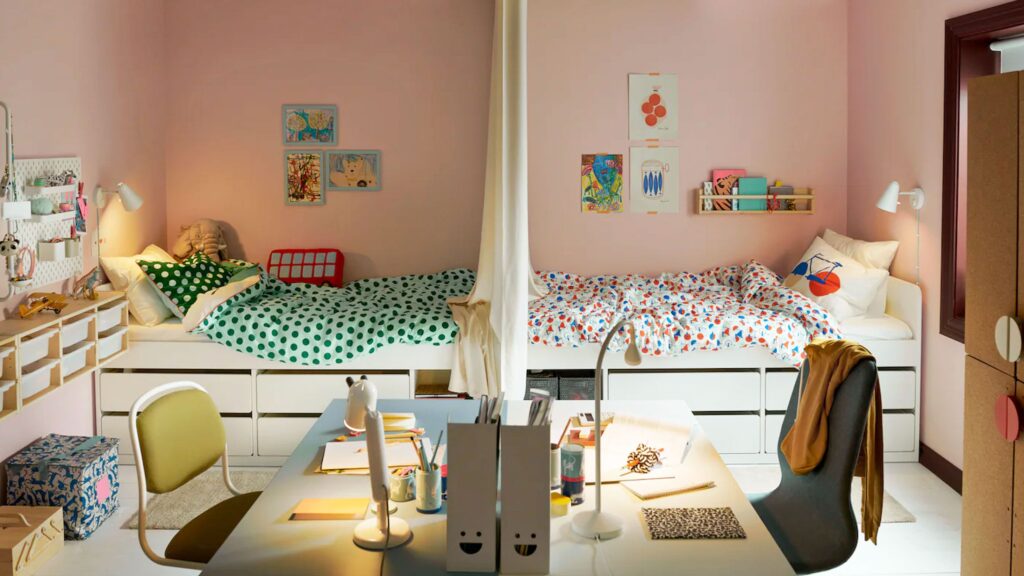Creating a shared bedroom that works for two or more children can be a challenge. Differing personalities, routines, and interests often collide in a single space. But when done right, a shared bedroom can foster creativity, bonding, and a sense of belonging among siblings.
In 2025, the focus in children’s bed design is on blending function with fun. Families are looking for solutions that maximise space, respect individuality, and grow with their kids over time. Here’s a guide to designing shared bedrooms that your kids will actually enjoy spending time in.
1. Start with a Clear Plan
Before buying furniture or painting the walls, take a step back and plan. Consider the age gap between children, their daily routines, how long they’ll share the room, and what storage or play needs they have.
Key questions to ask:
- Do the kids have similar or different sleep schedules?
- Is the room primarily for sleeping or also for playing and studying?
- How much storage is needed for clothes, books, and toys?
- Will the layout need to adapt in a year or two?
Good planning reduces future conflicts and helps you invest in furniture that lasts.
2. Choose the Right Beds
Bunk beds are often the go-to for shared bedrooms, but they’re not the only option. Depending on the room size and layout, you can explore:
- Twin beds arranged parallel or in an L-shape
- Loft beds with desks or storage underneath
- Stackable beds or trundles for sleepovers and flexible use
- Corner bunks that open up floor space in the center
Safety is key, especially with younger children. Make sure beds have proper guard rails, ladders are secure, and that there’s adequate headroom above top bunks.
3. Create Personal Zones
Even in a shared room, every child needs a sense of ownership. Giving each child their own defined area promotes independence and avoids conflict.
Ways to create personal zones:
- Use different bedding colours or patterns for each child
- Add wall shelves or pinboards for their artwork and items
- Assign separate drawers or labelled storage boxes
- Install privacy curtains around each bed or bunk
These small touches go a long way in helping kids feel like the room belongs to both of them equally.
4. Go Vertical with Storage
In a shared space, floor space is precious. Smart storage solutions that make use of vertical space can help keep the room tidy and functional.
Ideas include:
- Wall-mounted bookshelves or toy racks
- Over-the-bed storage cabinets or shelves
- Under-bed drawers for seasonal clothing or lesser-used toys
- Hanging organisers on the back of doors
Opt for storage units that are child-friendly in height and accessible for little hands.
5. Design a Flexible Shared Study Area
If your kids are school-aged, a dedicated place to focus on homework or crafts is essential. You can create a shared study zone with:
- A long desk with two chairs and desk lamps
- Split workstations with storage dividers
- Pegboards above each seat for their own school supplies
- Headphones or partitions if different noise levels are needed
A clutter-free workspace encourages focus and helps build good study habits from an early age.
6. Use Colour and Decor to Reflect Both Personalities
While it’s tempting to choose a uniform theme for the whole room, the best shared bedrooms balance unity with self-expression.
Tips for decor:
- Let each child choose their wall art, posters, or decals
- Mix and match cushions, rugs, or wall colours on each side of the room
- Choose a neutral base colour and layer personality through accessories
- Include their names or initials as part of the decor
This approach makes the room feel fair and fun, while still visually cohesive.
7. Keep it Play-Friendly but Organised
A shared room should encourage play and imagination, but also provide systems to keep clutter at bay. Consider:
- Foldable play mats or pop-up tents that can be stored easily
- Toy rotation systems to limit how much is out at once
- Open bins for quick clean-up
- Rules or schedules for sharing favourite items
Including your kids in organising their play area can make tidying up part of the fun.
8. Plan for Growth
A room that works now might not work two years from now. To avoid frequent re-designs, choose furniture and layouts that can evolve as your children grow.
Tips to future-proof the room:
- Choose adjustable desks and chairs
- Use neutral or timeless themes for big pieces like beds and wardrobes
- Add modular storage units that can be rearranged or expanded
- Keep wall paint and flooring classic, and update with changeable decor
Involving older kids in design choices can also help make sure the space continues to reflect their needs and interests.
Final Thoughts
Designing a shared bedroom your kids actually love is a mix of smart planning, thoughtful design, and a little creativity. When every child feels included and the space is designed to support both shared time and personal space, a shared bedroom becomes much more than a compromise. It becomes a place where siblings bond, grow, and create memories.
Whether you’re dealing with tight spaces or just looking to strengthen family connections, these tips can help turn one room into a space that truly works for everyone.



